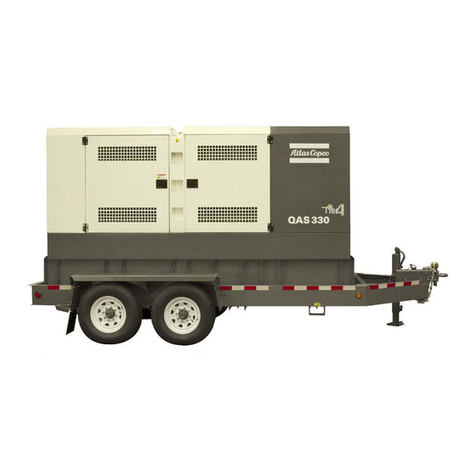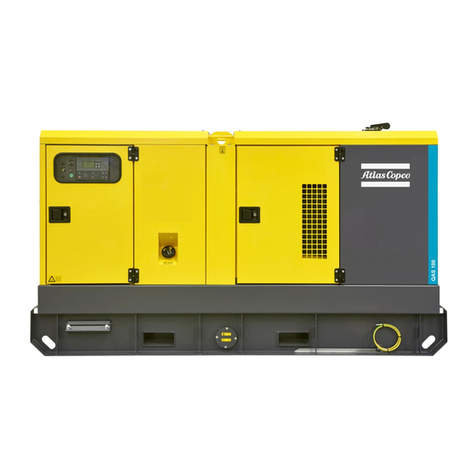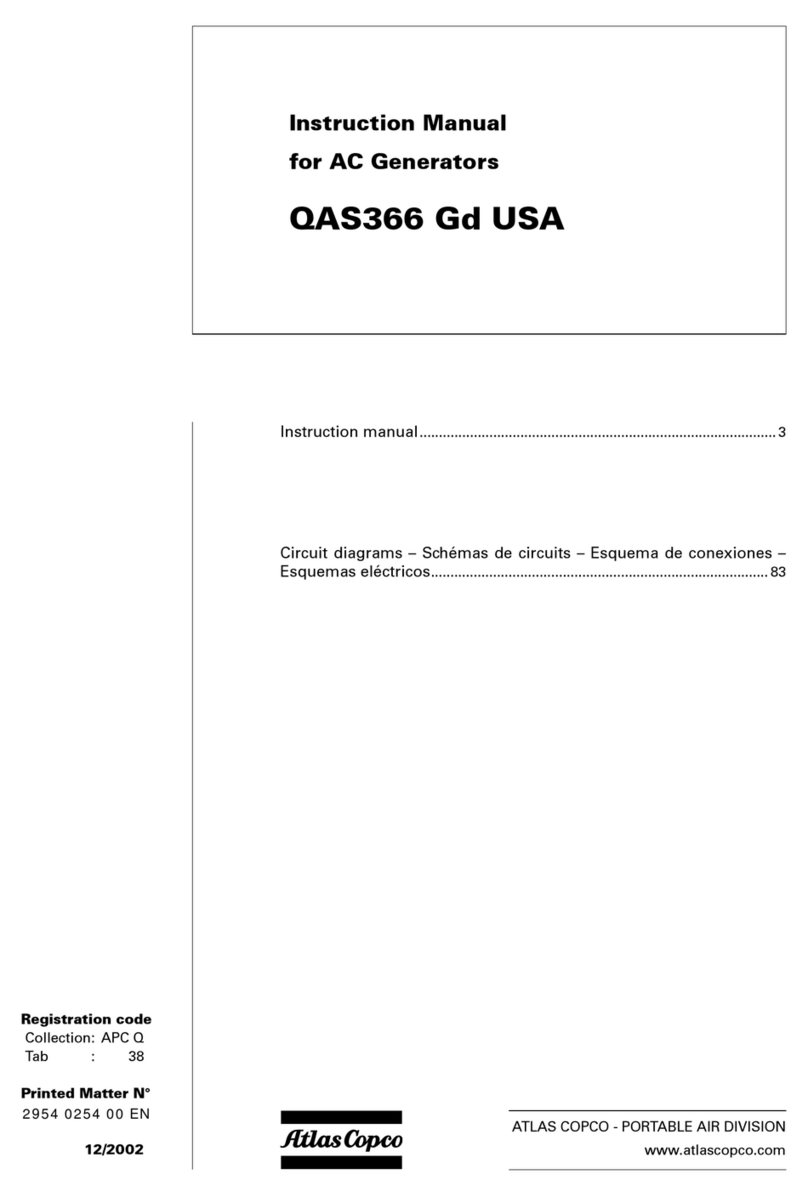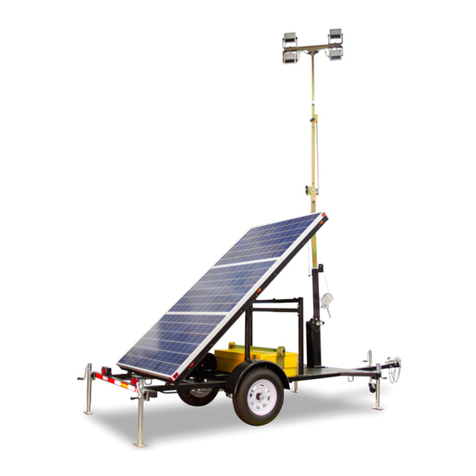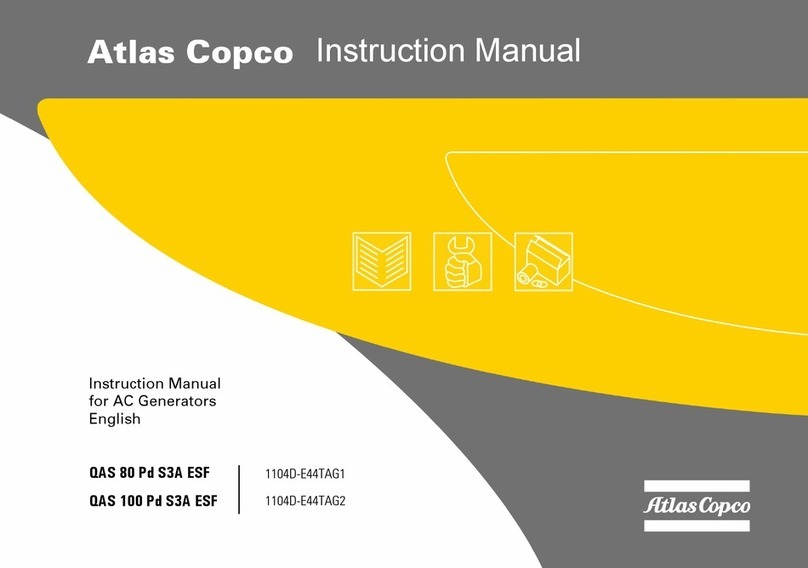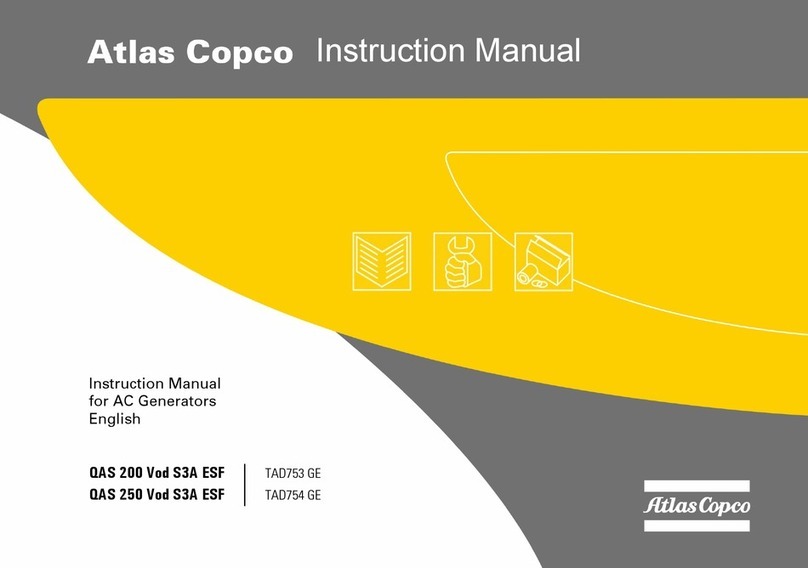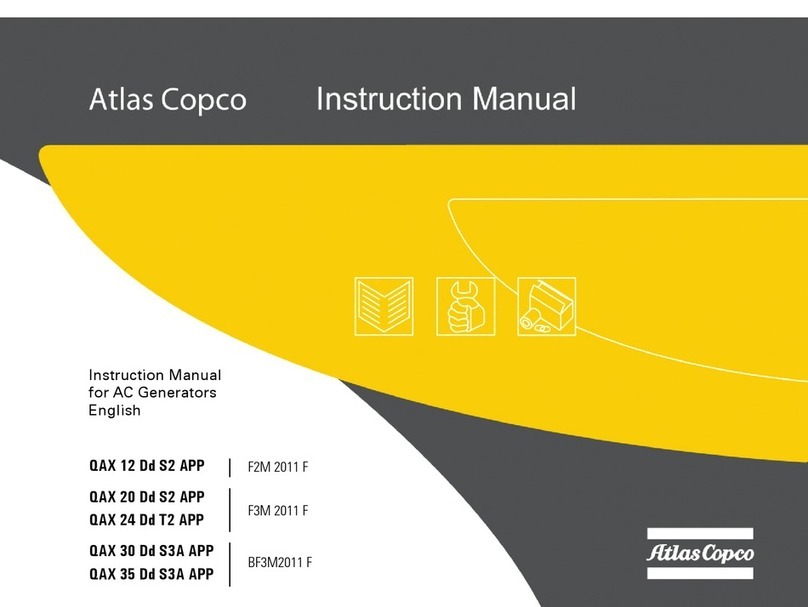SAFETY PRECAUTIONS FOR GENERATORS QAS
Everyone who uses or maintains Atlas Copco equipment is expected to read the
following safety precautions attentively and to act accordingly before installing,
operating or repairing the generators.
The operator must employ safe working practices and observe all relevant local
safety requirements.
The owner is responsible for maintaining the unit in a safe operating condition.
Parts and accessories shall be replaced if unsuitable for safe operation.
Installation, operation, maintenance and repair shall only be carried out by
authorized, competent personnel.
Any modification on the unit shall only be performed in agreement with Atlas
Copco and under supervision of authorized, competent personnel.
If any statement in this book, especially with regard to safety, does
not comply with local legislation, the stricter of the two shall apply.
Ignoring these safety precautions may result in injury or death of the
operator and/or people in the vicinity.
In addition to normal safety rules which must be observed with generators, the
following safety precautions listed hereafter are stressed.
INSTALLATION PRECAUTIONS
1. Generators shall be lifted only with adequate equipment in conformity with local safety
rules. Loose or pivoting parts shall be securely fastened before lifting. It is forbidden to
stay in the risk zone under a lifted load. Lifting acceleration and retardation shall be kept
within safe limits.
2. The aspirated air shall be free from flammable or toxic fumes, e.g. paint solvents, that can
lead to internal fire or explosion.
3. Generators shall be installed on an even, solid floor, in a clean location with sufficient
ventilation. If the floor is not level or can vary in inclination, consult Atlas Copco. If the
unit is installed on a trailer, immobilize the trailer and chock the wheels.
4. The engine exhaust is a lethal gas. Do not operate the unit in a confined, not-ventilated
room.
5. Never remove or tamper with the safety devices, guards or insulations fitted on the
machine.
6. The electrical connections shall correspond to the local codes. The machines shall be
earthed and protected against short circuits by fuses or circuit breakers.
7. Damaged cables and insufficient tightening of connections may cause electric shocks.
Replace damaged cables and make sure that all electric connections are securely tightened.
OPERATION PRECAUTIONS
1. Operate the unit as described in the Instruction book to ensure safe, efficient operation.
2. Never operate the generator in excess of its limits as indicated in the technical
specifications and avoid long no-load sequences.
3. Never operate the generator in a humid atmosphere. Excessive moisture causes worsening
of the generator insulation.
4. Never touch the power terminals during operation of the machine.
5. Keep all bodywork doors shut during operation. The doors may be opened for short
periods only, e.g. to carry out routine checks. Wear ear protectors when opening a door.
6. People staying in environments or rooms where the sound pressure level reaches or
exceeds 90 dB(A) shall wear ear protectors.
7. Periodically check that:
a. All guards are in place and securely fastened.
b. All hoses, cables and/or pipes inside the generator are in good condition, secure and
not rubbing.
c. There are no leaks.
d. All fasteners are tight.
e. All electrical wirings are secure and in good order.
8. Do not remove any of, or tamper with, the sound-damping material.
9. Whenever an abnormal condition arises, e.g. excessive vibration, noise, odour, etc., switch the
circuit breakers to OFF and stop the engine. Correct the faulty condition before re-starting.
10. Never refill fuel while the machine is running. Keep fuel away from hot pipes. Never
smoke while fuelling. Do not spill or leave fuel, oil, coolant or cleansing agent in or
around the unit.
11. Keep flammable material away from the machine. If required, provide a spark arrestor to
trap incendiary exhaust sparks.
12. Earth the generator as well as the load properly.
13. Check the electric cables regularly. Whenever damaged wires or dangerous conditions are
observed, switch the circuit breakers to OFF and stop the engine. Replace the damaged
wires or correct the dangerous condition before re-starting.
14. Avoid overloading the generator. The generator is provided with circuit breakers for
overload protection. When a breaker has tripped, reduce the concerned load before re-
starting.
15. If the generator is used as stand-by for the mains supply, it must not be operated without
control system which automatically disconnects the generator from the mains when the
mains supply is restored.
16. Never remove the cover of the output terminals during operation. Before connecting or
disconnecting wires, switch off the load and the circuit breakers, stop the machine and
make sure that the machine cannot be started inadvertently or there is any residual voltage
on the power circuit.
17. Never connect the generator outlets to an installation which is also connected to a public
mains.
18. Before connecting a load, switch off the corresponding circuit breaker, and check whether
frequency, voltage, current and power factor comply with the ratings of the generator.
19. Running the generator at low load for long periods will reduce the lifetime of the engine.
20. Diesel engine exhaust and some of its constituents are known to the State of Califorina to
cause cancer, birth defects, and other reproductive harm.
MAINTENANCE PRECAUTIONS
1. Use only the correct tools for maintenance and repair work.
2. Use only genuine spare parts.
3. All maintenance work, other than routine attention, shall only be undertaken when the
generator is stopped and when all loads are disconnected from the machine. Ensure that
the machine cannot be started inadvertently.
4. Scrupulously observe cleanliness during maintenance and repair. Keep dirt away by
covering the parts and exposed openings with a clean cloth, paper or tape.
5. Protect the air filter, electrical and regulating components, etc. to prevent moisture from
entering them, e.g. when cleaning. Take care that moisture does not penetrate any
component.
6. Never remove a filler cap of the cooling water system of a hot engine. Wait until the engine
has sufficiently cooled down.
7. Never use flammable solvents or carbon tetrachloride for cleaning parts. Take safety
precautions against toxic vapours of cleaning liquids.
8. Take precautions against fire. Handle fuel, oil and anti-freeze with care because they are
inflammable substances. Do not smoke or approach with naked flame when handling such
substances. Keep a fire-extinguisher in the vicinity.
9. Make sure that no tools, loose parts or rags are left in or on the generator. Never leave rags
or loose clothing near the engine air intake.
10. Before clearing the generator for use after maintenance or overhaul, submit it to a testrun,
check that the AC power performance is correct and that the control and shut-down devices
function correctly.
11. When servicing batteries, always wear protecting clothing and glasses. The electrolyte is a
sulphuric acid which can cause severe burns. When charging batteries, an explosive gas
forms above the cells and escapes through the vents. Do not smoke near batteries being,
or recently having been charged. Never break live circuits or battery terminals, because a
spark usually occurs.
12. Make sure that all sound-damping material is in good condition. If damaged, replace it by
genuine Atlas Copco material to prevent the sound pressure level from increasing.
4
QAS108 Pd(S) Mk II
